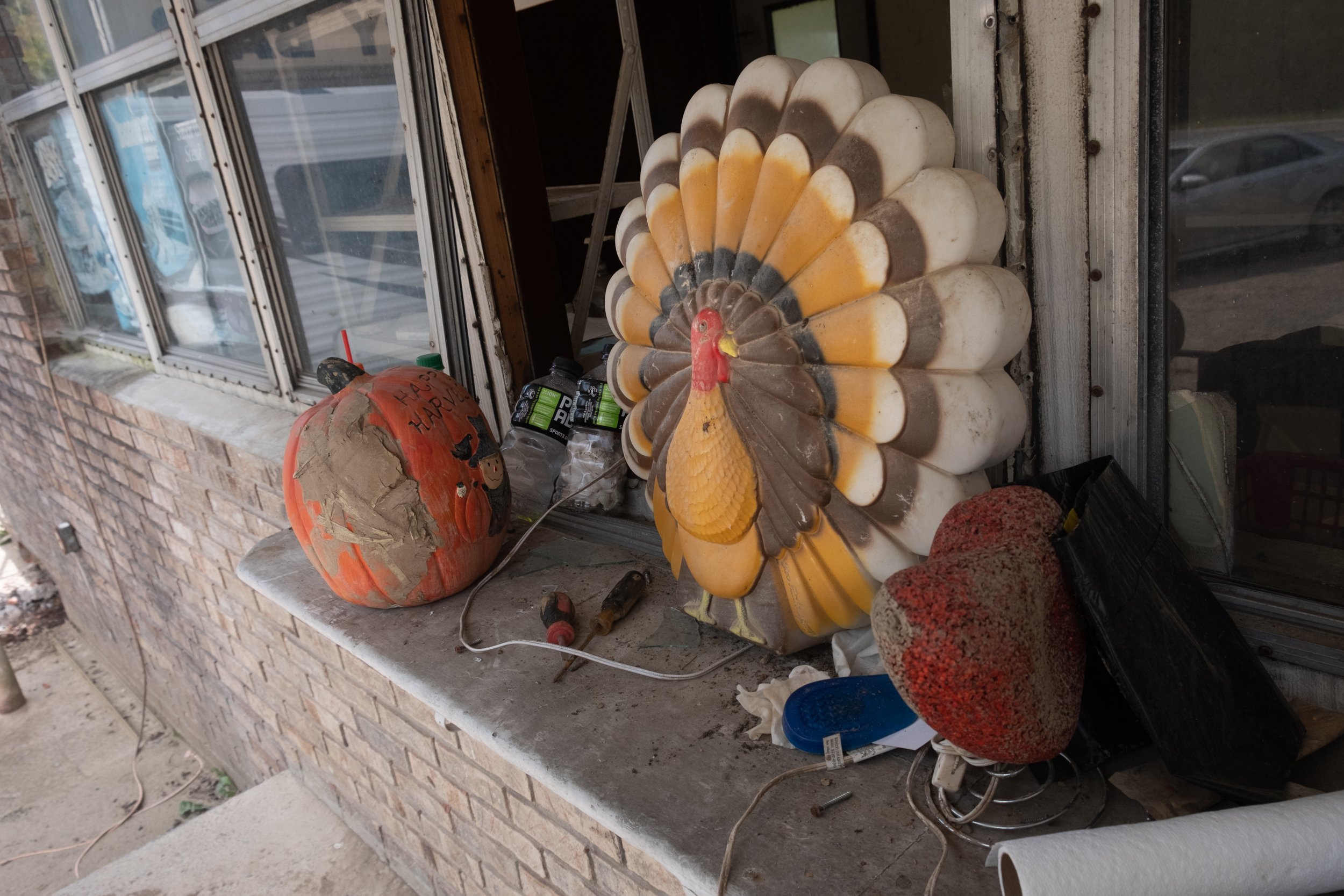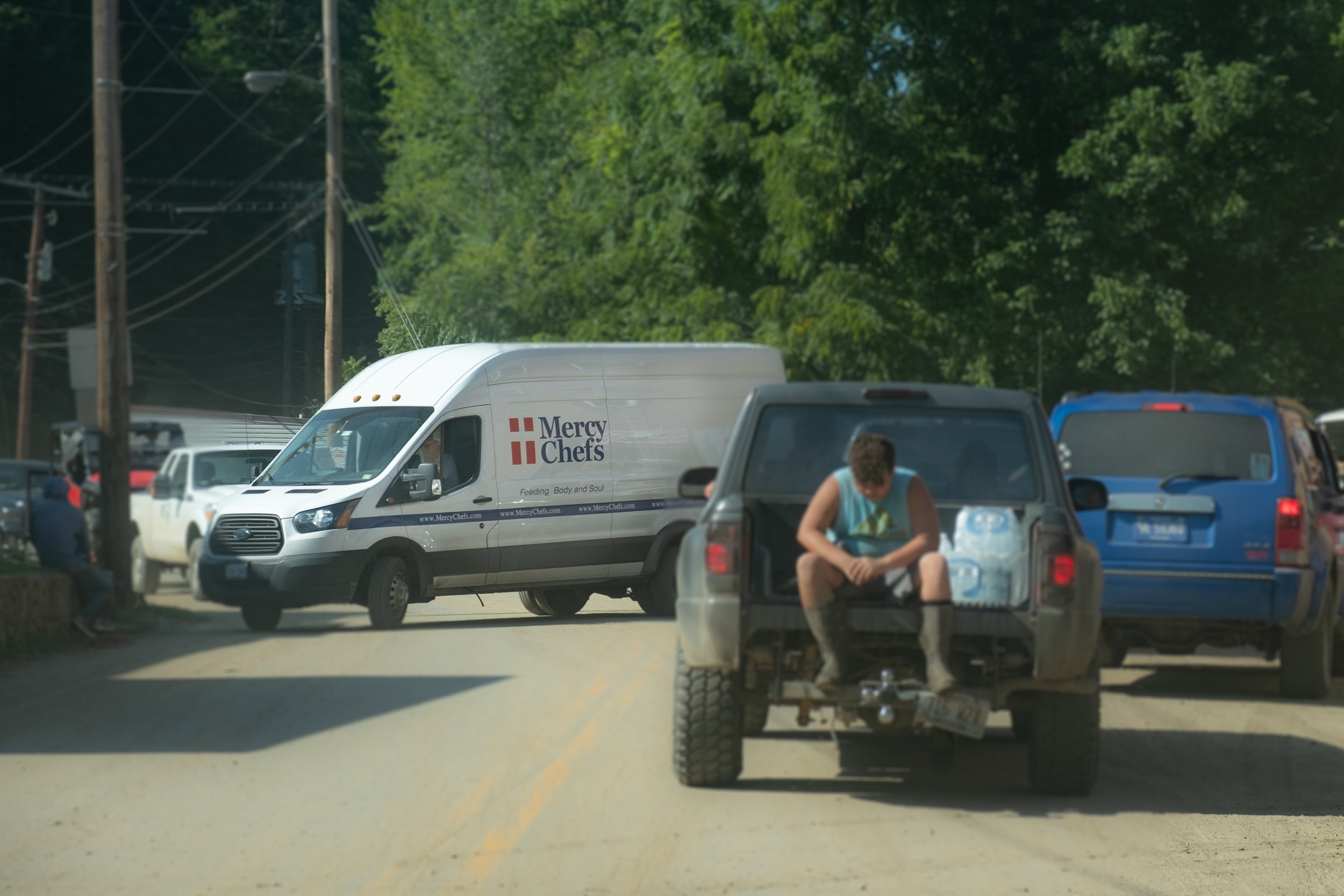Santa Claus may need a little help this year
Near Neon, Kentucky a headless Santa Claus sits in the August sun.
Near Neon, Kentucky a headless Santa torso sits amidst the debris and ruin left by a thousand-year flood that swept away property and lives in the middle of a dark summer night. Survivors all tell similar stories about the noise and fear that swelled in the pre-dawn hours of July 28th in eastern Kentucky. Water roared down hollers, climbed river banks, and tore through towns with no regard for life or limb.
That’s the night this velvet clad Saint Nick was muddied and mangled in the old freezer building where Doloris Johnson stored her holiday decorations. Doloris and her late husband, Mike, ran Johnson’s Dairy Bar for almost 40 years. Besides delicious food, the place was known for seasonal decorations. Years ago, they rigged this life-sized Santa torso with speakers and a microphone, so that customers could stand on the porch and place their order with Santa. “We could talk back with them from a microphone inside,” Deloris recounts.
This Santa could converse with patrons at Mike Johnson’s Dairy Bar which sat at what’s known as The Junction near Neon, Kentucky.
The ruined restaurant will undergo a mandatory demolition. A former employee came and removed the window painted “The Lord will restore” and brought it to Deloris. (The window pre dated the flood.) “She knew how much that window meant to me,” Deloris told me, choking back tears.
I met Deloris and her sister, Billie Jean Johnson, in early September while visiting some ravaged communities in eastern Kentucky. They were doing their weekly cleaning of the sanctuary at the Haymond Free Will Baptist Church they attend. When I asked if I could share their story and image they did not hesitate, saying “if you think it will help.” This was about one month after the flood, and Deloris could hardly speak without crying, but she wanted to tell me what had happened to her the night of the flood.
Deloris Johnson inside the Haymond church. She cries while recounting what happened to her the night of the flood.
Deloris’ sister, Billie Jean, standing in front of the church sign. Haymond, Kentucky.
The sisters clean the sanctuary each week.
Deloris lived in a trailer which was parked near the Dairy Bar. (The trailer was first purchased decades ago as a place for her father-in-law to reside close to the workplace so Deloris and Mike could look in on him regularly.) Locals call the area The Junction, and it sits just southeast of the tiny town of Neon, sometimes called Fleming-Neon. Awoken by noise and rising waters, she made a phone call to her nephew who lived just about 100 yards from her in a doublewide trailer. At that point the water had risen in her home to almost her waist, but he told her to wait there until the water subsided. She began praying. Cell service went out. She waited in the dark, with the wrathful waters swirling around. About an hour later, in between downpours, as the water level went down a few feet, her nephew waded to her house, and together they made their way to higher ground before the waters rose again.
When the sun rose, and the waters began to recede, the devastation was overwhelming. Dozens of people were dead, and dozens more missing. As of December, the final death count is 43.
A boot print on about a foot of mud inside a ruined game room in downtown Neon. Look closer, and you can see the line of the floodwaters just above Marilyn Monroe’s cleavage.
When I returned to visit with Deloris in October, the mangled mobile homes had been removed from the property, new temporary electric hookups installed, and she was living in a very small travel camper that someone loaned her. At that point, FEMA had refused to provide Deloris with housing funds because she owns another home. However, the home she owns is remote and in disrepair since her husband died. She doesn’t drive so it’s not practical for her to return to the old house up the mountain. So, for now she’s facing winter in the tiny camper. (Her situation is unique, and it’s not my intent to elaborate on that here. Find links to FEMA’s work in Kentucky below.)
What a flood can, and cannot, take away
The day I was there this Fall, a local resident was helping diagnose and repair the water line to and from the small abode. When I asked his name, he said people would know him best as “Ray Ray.” Aaron Ray Dotson was also going to drive Deloris to some errands that day. She relies on friends and family to take her to the grocery store, doctor’s appointments, and church. She told me Ray Ray was going to take her to Whitesburg the next day to meet with a group of lawyers who were helping people appeal their settlements with FEMA.
Aaron Ray Dotson working on the water line from the travel trailer.
Another young man named Tim Seals arrived to replace the small propane tank on the camper with a bigger tank. “Winter is coming, and we just want to make sure people are warm,” he told me. His family owns a bottled gas company.
Both of the men helping knew her well, and I felt the sense of community that morning. People looking out for each other. Of course, this is only one story among thousands, and I’m aware of the hazards of suggesting a pattern from the particular. Yet, I saw that almost everywhere I went over several visits to Letcher County, Kentucky. But all the community and resilience can’t change the profound effect this flood had on Deloris and thousands of others. And this is just a small glimpse of one of this year’s severe weather events compounded, if not caused, by climate change. At least 10,000 homes were left unlivable after this particular flood, creating thousands of climate refugees here in the Appalachian mountains. Here are recent relief numbers from FEMA.
Beyond eastern Kentucky, in 2022 alone, damages to property from storms, fires, and floods is estimated at $260 BILLION. And that’s just the number we can put on material losses. Can we even fathom the mental health impacts? What price have individuals paid who lost a sense of security? How do we mitigate that? How do we find hope, let alone joy, again? What needs to happen at a policy level? What do we do as individuals to become part of the solution?
Tim Seals explains to Deloris how he will replace the small propane tank with a bigger one to help keep the travel trailer warm this winter.
When I returned in October, the headless Santa was gone, having become part of the roughly 150,000 pounds of debris hauled off to landfills. On the porch of the ruined restaurant one plastic Thanksgiving turkey perched alongside several photo albums splayed open, the muddy imagery a testament to life before the flood. Most of the pictures in the album were ruined by the indifferent water, and the mold that followed. The silt caught in the plastic sleeves like salt in a wound.
There’s no price that can be put on the emotional power of photographs to trigger memories. Deloris looks thru albums she tried to salvage.
Having your visual keepsakes spoiled seems especially sad. Most material things can be replaced, but not old photographs.
One of the photos that’s still relatively unharmed shows Deloris in her early twenties, and is labeled “Christmas Day, 1976.” Forty-six years later Christmas is approaching.
The barrage of holiday messaging is reaching full frenzy with headlines that demand “Give the perfect gift,” or “Be the hostess they remember.” Even more indicative of our penchant for stuff is a recurring headline every year that says “The perfect gift for someone who has everything.” (Wouldn’t the perfect gift for someone that has everything be nothing?)
Imagery of flawless families in designer rooms with glittering decorations and precisely wrapped presents assault us in our mailbox, online and even at the gas pump. We live in a culture of consumerism that constantly tells us we can only be happy with more shiny stuff. Our very spirits have been corrupted by greed, and it’s painfully amplified with the commercialization of Christmas.
Santa may have lost his head, but he has not lost his heart.
Meanwhile, I’m haunted by the headless Santa Claus in eastern Kentucky. This Santa has no lap to sit in. No jolly face and long beard.
And yet. And yet, he’s got heart.
What we all need this Christmas.
After the July flood, volunteers from near and far showed up eastern Kentucky. Those who could, worked physically, cleaning and cooking, digging out, and delivering supplies. Others gave money. Others gave of themselves emotionally and spiritually.
The true spirit of giving, whether at Christmas or anytime, is a beautiful renewing act, lifting up the giver and the receiver. Give as you are able, somewhere it’s truly needed. In eastern Kentucky, Santa may need a little help this year.
There are many ways to give. Here’s one.
In the gallery below, click an image to see it full frame.



















